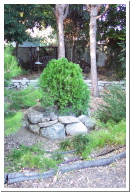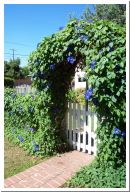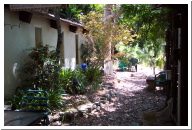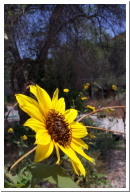These folks have a host of gardening tips and advice on their site. Some of the more advanced information, like Installing a garden pond, come with Flash animation slide shows for each step in the project.
Home -- Contact Me -- Search Welchwrite.com -- Subscribe to AGN ![]()
Douglas' Events, Appearances and Seminar Calendar
Saturday, August 30, 2003
Wednesday, August 27, 2003
Prepping for our big pasta/potluck garden party this weekend, so we are in major cleanup mode.
Tonight, I trimmed back our sprawling rosemary bush, as it was encroaching on other plants in the bed. Now it looks nice and neat. The trouble is, I have enough rosemary to supply every restaurant in the San Fernando Valley. Worse still, I don't use a lot of rosemary in my cooking, although I do sometimes brew up a cup of rosemary tea to calm my stomach.
I took the trimmings, bundled them together and hung them up to dry on the back patio. I am going to offer them up to party guests on Sunday. We have a few gourmet/gourmand among our friends so that should reduce the number somewhat. It makes me wish I had a big piece of pork to roast over an open flame, tossing the rosemary stems in the fire for a little extra flavor. Hmmmm.
Monday, August 25, 2003
The folks over at Recommendo posted and item about High Country Gardens, a company specializing in plants for Western Gardens.
These plants are delivered as seedlings instead of seed, to give them a better start in difficult environments.
Personal experience with the company is available in the Recommendo article.
I came across this blog in my Feedster search for gardening information. I use this to keep up on what other people are saying about their gardens.
The Garden Spot resembles this blog in that it is a recounting of the daily trials and tribulations of gardening. It could be especially helpful if you are gardening in Texas, like the authors.
There are lots of good links, many of which I will be visiting as soon as I post this entry.
Sunday, August 24, 2003

While visiting the Getty Center yesterday, (August 23), I came upon the idea of creating a walk-through of the striking gardens, for those of you who have never had a chance to visit.
While it is far from a comprehensive survey of the garden, I hope it will give you a small idea of what it is like. (Click the photo or go directly to the photo gallery.)
The garden changes from season to season, especially so in Winter when the Sycamores lose their leaves. The meandering path takes on an entirely different character. The usually shaded path opens to the sky, letting in the warming Witner Winter sun, low in the sky.
We live just down the hill from the Getty Center, and visit frequently. Even my 5-year-old, Joe, loves the place. The gardens give him some room to roam and there is an excellent Family Room with lots of kid activities, including dress up costumes.
I hope you enjoy this photo visit.
This is a nice article from the Arizona Daily Star in Tucson on attracting butterflies to your garden. I must be doing something good by accident as I tend to have a good collection of butterflies visiting my garden. I am sure, though, that some more information like this and I would be able to attract even more.
Thursday, August 21, 2003

Time, energy level and an upcoming party led me to attack a project that has been on my to-do list for a long time. In our back garden, there is a hill, with one yew bush perched on top, that was, at one time, part of the Japanese theme of the garden. Over the years, the larger rocks have receded into the soil and its river rock covering disappeared as well.
The first item was to roll aside the larger rocks and try to recover as much of the river rock as possible for later use. My wife and son helped to gather them up and we found probably 20-30 pounds of the small stones. These we attempted to clean up and then set them aside.
After moving the larger rocks out of the way, I trimmed the circumference of the hill down to a more manageable size. My goal was to insure that the larger rocks could encompass the entire hill with perhaps a few stones left over for a second tier. The soil removed from the hill was used to fill in the depressions left by the stones and to add soil to the top of the hill itself.
After replacing all the large stones around the newly sculpted hill, I used additional soil to backfill the interior of the hill, forming a more level top than before. Over this layer of soil, I added a light covering of cement, making sure to pour some into the inside crevices of the larger stones. I then covered the top with the salvaged river rock, making a nice neat covering once again. Once this was completed, I lightly watered the entire structure, wetting the concrete and cleaning the rocks themselves.
It is my hope that the cement will lightly knit together the structure and help to hold the rocks in place when we do get our Winter rains. I took the idea from an article I saw in Sunset Magazine about developing garden paths. In their example, the path was cleaned and a bed of decomposed granite was laid. On top of that, dry cement was spread lightly over the entire path. Then the path was watered. This results in a wonderful natural looking pathway that is much more resilient than a loose covering of the stone. I plan on trying out that method for my paths at a future date.
The picture gallery contains a few pictures showing before and after. They are part of the My Garden gallery, so you may have to scroll down a but to find them.
I think the rebuild was a nice improvement to the back garden and hopefully it will last another 17 years before needing another rebuild. If you have any questions or comments, please forward them to me and I will share them here.
Wednesday, August 20, 2003

Sometimes when your own gardening isn't going as well as it should, it can help to take a look at someone else's plants. This might also be a nice place to visit in a few months as we move into Fall and Winter. Dream a little dream.
This site includes botanical printers, flowers in paintings and Rose engravings by Pierre Joseph Redoute, a French botanical artist of the early 19th century.
Monday, August 18, 2003
A few days ago, I posted a picture of this caterpillar. Soon after the picture was taken, it started its cocoon and its transformation into a butterfly. Joe has been quite fascinated.
Click for larger image
Friday, August 15, 2003
This interesting site gives a code of conduct for dealing with invasive plants in your area.
In California, invasive plants are a major problem and various groups hold non-native cleanup days in parks and wildlife areas where the native plants are in danger of being driven out.
Courtesy of the Missouri Botanical Garden via About.com.
Thursday, August 14, 2003
Today's LA Times, has a neat article on children in the garden, Something to Grow On.
I know that my son is fascinated with what goes on in our garden, so I am sure other children feel much the same way. The article includes ideas for engaging your children in the wonders of growing your own plants, whether for food or decoration.
The article also includes a sidebar discussion with Sharon Lovejoy, author of Roots, Shoots, Buckets and Boots, a gardening activity book for children.
Fore more information, see:
Roots, Shoots, Buckets & Boots: Gardening Together With Children
Monday, August 11, 2003
A Guide to the World of Fun and Clever Gardening.
This site is a great introduction to gardening for kids. It includes activities, information and a teacher's guide on how to integrate gardening into the classroom.
Grounds for Pleasure: Four Centuries of the American Garden
Much like many of you dream over plant and seed catalogs in the depths of Winter, I am perusing gardening books as I wait out our August heat wave. We have been experiencing highs in the mid to upper-90's the last week or so. I just can't bring myself to do even the smallest gardening tasks in such heat, unless I work after the sun goes down.
This book is an excellent way to spend some time. A thorough retrospective of the history of American gardens, its text and wonderful photos help to show you what the designer was trying to accomplish and how the design changed with age. I have just been flipping through looking at photos and reading captions, but now I am going to go back and do some more in-depth reading.
Most of the gardens in the book are large scale design, but I have found many elements that can be used in even the smallest gardens.
If you are taking some time to rest after your garden work, this is the perfect book to carry to your garden chair, along with a cool glass of ice tea, and lose yourself among its pages. Both you and your garden will be better off for the visit.
Thursday, August 07, 2003
I have added a few more photos of the front garden to My Garden photo gallery this afternoon, including this nice shot of a caterpillar.
Click photo for larger image and gallery
I believe this is a Gulf Frittillary (Agraulis vanillae). They really like Passionflower vines and this is exactly where he/she is living at the moment.
Click Photo for Gallery
A fellow Tribe.Net user wanted to see more photos, descriptions and maps of other members gardens. This got me to thinking about a little project I have been meaning to do for a while...documenting our garden.
My Garden, a gallery of pictures showing various areas of the garden. I am hoping to expand this by including maps and plant lists over time, but for right now, it contains 2 photos looking into the garden from the back patio.
Hopefully, this won't expose too many of my limitations as a gardener, but, the heart of AGN is learning by example, both good and bad. Be kind!
The shot is taken facing due East around mid-morning today. In the bed along the left hand side you can see the Nandina, agapanthus, the small trunk if an overarching Locust tree, 2-3 iris, a gazing ball, my favorite tree, a Japanese Maple which is over-shadowed by the large Eucalyptus behind it.
Just peeking in on the right is the wisteria trellis.
The building you see is a 1970's addition to our 1943 house. It was designed as a master suite but now includes our extensive offices and a large play room for our son.
Wednesday, August 06, 2003
I am testing out a new feature on the web site today. As I post pictures from our travels, I am including some of them in DotPhoto. This allows you to browse and then purchase prints of the photos directly from DotPhoto.
You can click on the photo above to see two pictures I am using as a test.
If this system works out, I will be including photos from various WelchEvents and school events so that friends and parents can get real, photographic prints instead of printing them out themselves.
Here are some gardening links for the kids in your life. They cover everything from safe plants for a kids garden to using gardening as a science fair topic for older kids.
Monday, August 04, 2003

Local Harvest is a web site dedicated to helping you find the best in locally produced food products. You can put in your zip code and find farms, farmer's markets and restaurants near you.
Via MetaFilter
Sunday, August 03, 2003

Click picture for additional photos
This morning I decided to step away from the computer for a quick walk around the neighborhood. I remembered to take my camera this time, and captured a few of the plants in bloom at this time of year. The picking were somewhat slim, as the heat has caused most plants to peak weeks ago. That said, the tropical plants are doing well, even with the reduced humidity.
There are several homes with Morning Glory sprawled on fences and over gates. It is beautiful, but I have avoided it in my garden due to its habit of taking over everything. Since we don't get a killing frost here in the San Fernando Valley, Morning Glory can, and does, grow all year long. Some people might even classify it as an invasive plant out here.
Hibiscus loves the sun and the heat of the summer months, so there are almost always examples of it blooming throughout the city. People have trained them into some unlikely forms, too. I see hibiscus planted separately as specimen plants, mashed together to form hedges and trimmed into squares and balls like a yew bush. My hibiscus seem to thrive, but suffer a constant attack of white fly. II basically spray off the larvae and the adults whenever I am in the garden and I installed yellow sticky cards about a week ago, but it seems to do little.
There are some spectacular examples of Crape Myrtle around. My poor little one in the back garden had been suffering under the shade canopy of a large eucalyptus and ash tree, so it looks spindly and sickly. The examples in the photos, though, show what a crape myrtle should look like in the full bloom of health. I see quite a few of these trees in the Valley, but these are some particularly wonderful examples.
The plant information links above take you to Floridata.com. Check out there collection of plant information and their Gardener's Journal column.
Friday, August 01, 2003
This posting over at Stonewerks.net, is an important reminder to tread lightly when dealing with chemicals in your garden.
I try to use as few chemicals as possible. In order of importance, these are my reasons:
- I have a 5-year-old who loves to play in the garden
- I have loads of birds and beneficial insects
- I am too lazy to mix it up and apply it
If you are worried about pesticide exposure, here is a document to assist you:
How to Avoid Pesticide Injury (and what to do if you can't)
and a PDF document:







